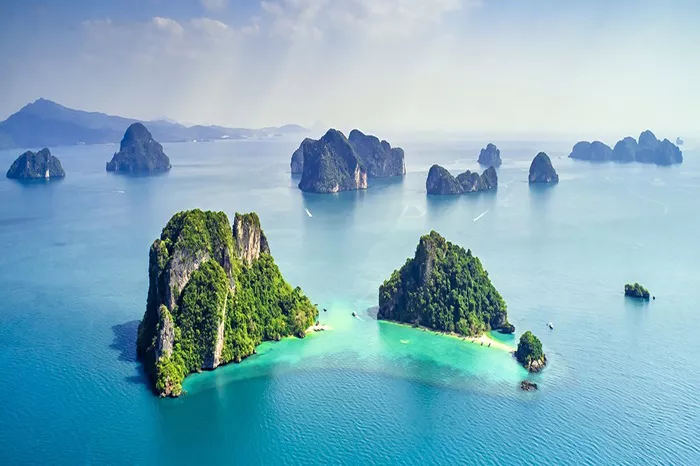Thailand’s Shift in Focus for 2025: Addressing Over-tourism with Sustainable Travel
Thailand, one of the world’s top travel destinations, is poised to welcome even more international visitors in 2025. As the country continues to be a leader in global tourism, renowned for its pristine beaches, vibrant nightlife, and rich cultural heritage, its booming tourism sector has also led to overcrowding at many popular attractions. To address the challenges of overtourism, Thai authorities are implementing new strategies to promote sustainable travel and protect the environment and local culture.
Maya Bay: A Case Study in Overtourism and Rehabilitation
One of the most notable examples of Thailand’s efforts to combat overtourism is Maya Bay, made famous by the 2000 film The Beach. Overcrowding at the bay led to severe environmental damage, affecting the beach’s water quality and surrounding landscape. To mitigate the impact, Thai authorities closed the bay in 2018 for a major rehabilitation project. After four years of restoration, Maya Bay reopened in 2022 with new visitor restrictions. During peak seasons, the bay is temporarily closed to tourists, with periods like August 1–September 30, 2024, designated as “off-limits” for recovery.
Encouraging Visits to Less-Explored Destinations
While tourism is crucial to Thailand’s economy, generating approximately $38 billion in 2023, the government is also promoting more sustainable travel practices. The initiative encourages tourists to visit less crowded destinations to ease the pressure on heavily visited places like Phuket, Chiang Mai, and Koh Samui. By leveraging digital tools and promoting hidden gems, Thailand aims to reduce overcrowding and stimulate economic growth in under-visited areas.
Regions like Nan and Lampang are gaining popularity as cultural hubs, offering authentic experiences away from the typical tourist trail. In the first half of 2024, international tourist visits to Lampang surged by 102% compared to the same period in 2023, signaling a growing interest in exploring these less-explored locales.
Hidden Gems of Thailand: Emerging Destinations for 2025
Thailand’s less-traveled destinations are becoming more appealing to visitors looking for a more serene and immersive experience. Chiang Dao, in northern Thailand, is known for its scenic beauty, hot springs, and bustling markets. The Chiang Dao Cave complex, with its illuminated caverns and Buddha statues, is a major draw for adventurous travelers.
Further south, Khanom in Nakhon Si Thammarat offers a peaceful coastal retreat, known for its unspoiled beaches and pink dolphin sightings. Situated near Koh Samui and Koh Phangan, Khanom is an ideal side trip for those seeking a quieter holiday.
Koh Kood, an under-the-radar island in Trat province near Cambodia, is famed for its crystal-clear waters and pristine beaches. With limited resort accommodations, the island promises an exclusive, tranquil experience, ideal for those seeking privacy amidst natural beauty.
Nan and Lampang: Cultural Experiences in Underrated Locations
Inland destinations like Nan offer an opportunity to connect with Thailand’s rich heritage. Known for its picturesque mountains, caves, waterfalls, and ancient temples such as Wat Phumin, Nan provides an authentic glimpse into the country’s cultural history.
Lampang, just 90 minutes from Chiang Mai, is renowned for its teakwood buildings and historical landmarks, including the ancient Wat Phra That Lampang Luang. The city’s vibrant street art scene and its historical sites make it an appealing stop for culture enthusiasts.
Sustainable Travel: The Future of Thailand’s Tourism Industry
Thailand’s growing emphasis on sustainable tourism is reshaping the country’s travel industry. By encouraging visits to lesser-known destinations and implementing measures to protect its natural and cultural assets, Thailand is adapting to the challenges posed by overtourism. This approach aligns with a global trend toward more responsible travel, as tourists increasingly seek authentic, crowd-free experiences.
The shift toward sustainability presents both challenges and opportunities for travel companies and local operators. To stay competitive, businesses will need to adopt innovative technologies and marketing strategies to promote these emerging destinations. Meanwhile, tourists are likely to find themselves drawn to remote, culturally rich locales that offer more personalized and meaningful travel experiences.
What 2025 Holds for Thailand’s Tourism?
As Thailand enters 2025, the tourism industry faces the challenge of balancing growth with preservation. By focusing on sustainable tourism, promoting emerging destinations, and implementing environmental safeguards, the country is set to offer a more diverse and responsible travel experience.
Tourists will be encouraged to explore new, off-the-beaten-path destinations while enjoying Thailand’s natural beauty and cultural richness. This emphasis on sustainability, authenticity, and local engagement will define the future of Thai tourism, ensuring that it remains a key economic driver while protecting the country’s precious resources for generations to come.
Related topics:
- Indian Government Launches Measures to Promote Balanced Tourism Growth
- Northern Rivers Rail Trail Achieves Sustainable Tourism Accreditation
- Saudi Arabia to Launch VAT Refund System for Tourists in 2025, Boosting Tourism Sector

